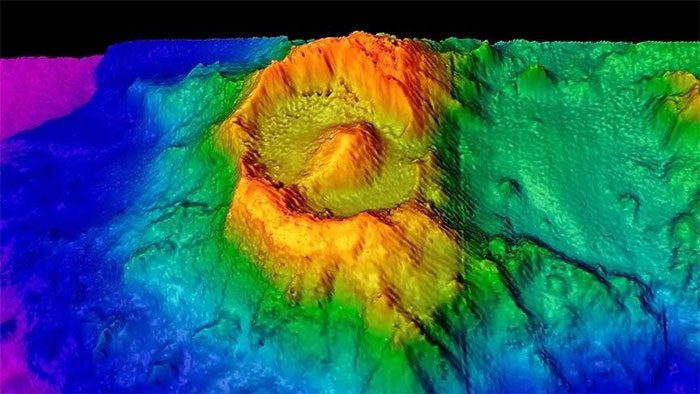Researchers in the Indian Ocean have discovered the remnants of an underwater volcano with a peculiar shape resembling the “Eye of Sauron” from the famous fantasy series “The Lord of the Rings” by author J.R.R. Tolkien.
The “Eye of Sauron” Volcano measures 6.2 km in length and 4.8 km in width. This caldera is the result of the ancient collapse of a volcano on the deep seabed. It is surrounded by a rim that rises 300 meters, giving the impression of an eyelid, with a conical peak at the center, resembling a pupil.

An ancient volcano over 100 million years old, intact beneath the sea in Australia.
This strange volcano is located approximately 280 km southwest of Christmas Island, Australia, which is an external territory of Australia. It lies at a depth of 3,100 meters.
A team of researchers discovered this structure while aboard the ocean research vessel Investigator, owned by the Commonwealth Scientific and Industrial Research Organisation (CSIRO) of Australia, on the 12th day of their expedition to Australia’s Indian Ocean Territory. Like other volcanoes, this volcano formed when the summit of the original volcano collapsed.
“Molten magma beneath the volcano moved upwards, leaving voids below. The thin, solid crust on the surface of the dome then collapsed, creating a large structure resembling a caldera,” said Chief Scientist Tim O’Hara, a senior researcher at Museums Victoria in Australia.
Continuing the connection to Tolkien’s fantasy novel, the researchers named the conical structure Barad-dûr, after Sauron’s main fortress, and the connecting ridge Ered Lithui, named after the Ash Mountains, both of which are found alongside the Eye of Sauron in the dark realm of Mordor. Ered Lithui is part of a cluster of formations believed to be around 100 million years old.
Over millions of years, sand and debris—particle material including plankton, feces, and other organic matter—has covered the formation with a sediment layer approximately 100 meters thick. However, the caldera remains relatively intact upon discovery.
O’Hara noted: “This rate of sedimentation should have eroded and concealed part of the caldera. Yet it appears surprisingly intact for a structure that is supposed to be 100 million years old.”
This integrity suggests that the volcano was formed, then collapsed, and sank into the ocean.





















































